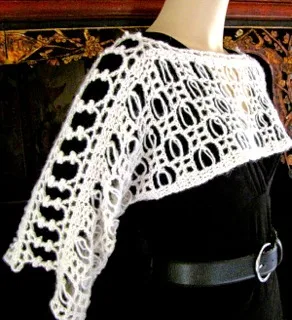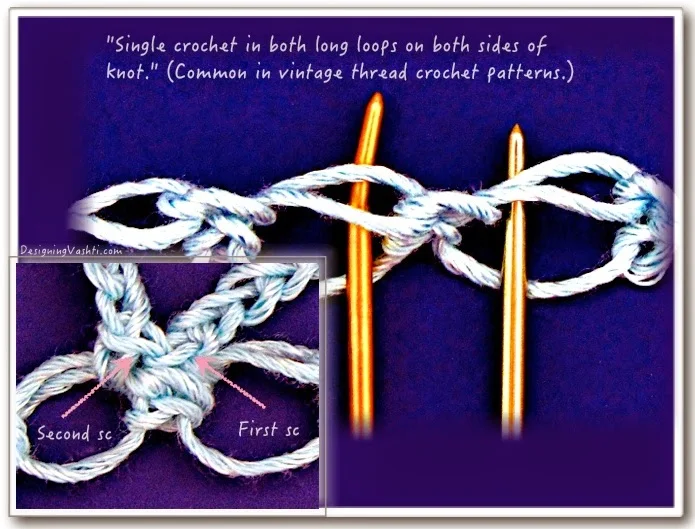 |
The moral of the story is, if you think you're looking
at the tops of stitches, you probably are. Orbit Cowl |
The third loop is required for "camel crochet." It has also been called the hump, bump, nub, lower loop, back-back loop, and lower horizontal bar of the single crochet (sc in the US; double crochet or dc in the UK and Australia). The patterns that result from using this loop in different ways have been called Savvy Single Crochet, and Camel Crochet™.
 |
Pallas Scarf uses a few kinds of third loop
stitches. Its prominent top loops give this
design a strong impact. |
I've listed these alternate names first so that crocheters searching for help have a chance of finding this post! For some reason this loop - a simple part of a simple stitch - is ignored in the crochet how-to books. (Be sure to see the end of this post for a chronological list of books that mention this topic somehow, and some how-to videos!)
It's not that I think beginners need to launch right into using it, but if it were named in a diagram along with other stitchy bits, it would give newbies a stronger foundation for broadening their understanding later. We'd have a common language. Designers wouldn't think twice before using it.
Here's how to find the loop in sc and use it. (Scroll down for hdc.) I've used it in a few of my patterns and want to use it more without confusing people.
 |
Single crochet stitches. This is a close up of the next photo below. I tinted the third
horizontal loop of the single crochets. The copper needle point is inserted through the
loop from under it, just like you'd do with the crochet hook for a nice ribbed look. |
1. Loosely crochet a row of some sc. You already know about the two top loops of a sc, right? They're the ones you crochet the next row of stitches into (unless directed otherwise). The top loop nearest to you is the front loop and the other is the back loop. These loops are labeled consistently in the books.
2. While you're crocheting each sc, you see the front of it. Look closely at how different the back is from the front of the stitch. The main difference is a small horizontal bump strand on the back only, just under the top loop.
 |
The fronts of the dark blue rows are facing us, and their top loops are bent over toward us, because the light blue rows were crocheted into this third loops. We're looking at the tops of their heads.
I crocheted the dark blue rows into both top loops of the light blue sc. |
Not only can you crochet into that third lower bump loop, you should! For more on the uses and possibilities of this third loop, please see issue #61, "Top Loops Optional," of Vashti's Crochet Inspirations Newsletter.
3. Finish your first row, chain 1, turn. Now the backs of the first row stitches are facing you. Look again for the third horizontal loop of the stitches. Skip the first sc and insert your crochet hook in the third loop of the next sc, from under the loop (not down through the top), then yarn over and pull through the loop. You should have two loops on your hook. Yarn over again and pull through both loops to complete a sc.
Three Tips!
It's weird and slow to crochet into this loop at first, but like everything, it gets easier. (I've only used the stitch in small strategic areas of my designs for effect.)
1. Keep stitches loose; use a larger crochet hook.
2. Use a pointy-headed crochet hook. You can even file the head of some of them to customize it.
3. Try this: when you pull up a loop in that third loop and leave it on your hook, pull up on it a bit. I've seen some people make their sc with their hook at an angle - angled toward the beginning of the row (held more horizontally than vertically). This makes a slightly stretched, taller sc with a loosened third loop, making it easier to crochet into.
The key to the effect is that none of the top loops of the first row are covered by stitches in the next row, so they ride along the surface as a neat chained-looking ridge.
Now for the Half Double Crochet (Hdc)
I hear some of you saying, "I do this already with hdc to make a squishy hdc ribbing!" And crocheting into the third loop of hdc is more common (though not as common as you'd think, if the crochet stitch guides are any indication). It's also easier because the third loop of hdc is looser.
 |
These are all hdc. I color-coded the two different kinds of "third loops."
The only one I've used in designs, and have seen others use, is tinted pink.
The lemon-tinted one is worth trying, though. It makes a rib that's less offset
and bent. It's structurally the same as the sc third loop. |
Interestingly, that hdc third loop is anatomically different from the sc third loop. (See newsletter #61 about this.)
I checked about 30 likely books for any explanation of this third loop of sc and/or hdc. Here's a chronological list of the what I turned up.
If you know of a source that is not on this list, please name it in the comments.
Note: some book titles are Amazon Affiliate links. If you click on them, it helps me out a little. Thanks!
1975: Golden Hands Special #40; Aran Crochet chapter, "Crochet rib stitch: …*work 1sc into horizontal loop below top of the next sc*…" and "Aran rib" (a row of hdc in the back loop only alternates with a row of third loop hdc).
1983/1985: Pam Dawson, Complete Book of Crochet; p. 116 "Single Rib Pattern" with diagram, in "Aran Crochet" chapter. same instructions as in Golden Hands (1975).
 |
Third loop crochet tends to be dense and warm; rows of
all sc or hdc in the top loops are too. This speedier third-loop
fabric is a light, airy, stretchy exception. Half Circle Handbag. |
1986 Denmark/1995 USA: Lis Paludan, Crochet: History and Technique; p. 233-235, "the loop behind the stitch" and "hook inserted into the little loop under the stitch," with a nice diagram. Two swatches: sc in third loop only with turning, and in the round with no turning. (Interweave Press; out of print)
2007: Bendy Carter, Single Crochet from A to Z Sampler Afghan™; pp. 6, 10, 13, 17. Three kinds of fabrics using this loop called "horizontal bar." (Annie's Attic/DRG.)
2007: Helen Jordan, Stitch Collection: Textured Crochet, see p.54-57; "Inserting your hook into different parts of the stitch, when working half double crochet makes quite a difference to the surface of your work."
2010: Karen Manthey, Crocheting for Dummies; in "Creating Texture in Unexpected Ways," I love the symbols given for the top front loop, top back loop, lower front loop, and lower back loop! States a "back-most loop" can be crocheted into for half double crochets and taller stitches.
Videos and Recommended Webpages:
------------------------
Karen Whooley's Savvy Single video. Link starts approx. 2 minutes in, when Karen has completed a row of the usual traditional single crochet stitch. She then goes on to show how to do the next row of single crochet in the third loop.
Kim Guzman's information page; includes videos.



.jpg)


.jpg)

















.jpg)












